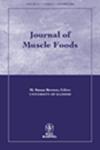The antioxidant and antimicrobial effects of each of different forms of garlic and BHA in emulsion-type sausage at 4C for 0, 10, 20 and 30 days were investigated. The treatments were divided into five groups: control, 30 g of fresh garlic /kg of sausage, 9 g of garlic powder /kg of sausage, 100 mL of garlic extract/kg of sausage and 0.1 g of BHA/kg of sausage. pH, peroxide value (POV), thiobarbituric acid reactive substance (TBARS), residual nitrite contents (RN) and total aerobic plate count (TAPC) were evaluated during storage. pH values and RN contents showed a significant decrease in all treatments during storage days. With the exception of POV value at 30 days of storage, an increase in POV, TBARS and TAPCs was observed in all treatments as storage time increased. In addition, the treatment with different forms of garlic and BHA during storage reduced pH, POV, TBARS, RN and TAPCs when compared with control. Consequently, the use of fresh garlic had much better antioxidant and antimicrobial effectiveness than other treatments.
Antioxidant or antimicrobial effectiveness is one of the major factors related to consumer acceptance for determining the quality of meat and meat products and their shelf life. The current study can be applied to prevent lipid oxidation and growth of microorganism in emulsion-type sausage and to produce new sausage formulations for a gradually increasing consumer acceptance. Based on the results, different forms of garlic can be used to improve oxidative stability of emulsion-type sausage and decrease the growth of microorganisms proving its antioxidant and antimicrobial effectiveness. The employment of natural additives in food preparations is perceived by consumers as a healthier practice than the addition of synthetic additives.


